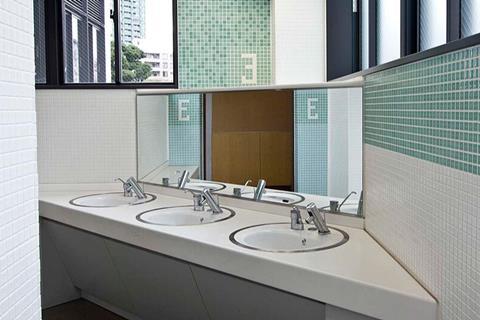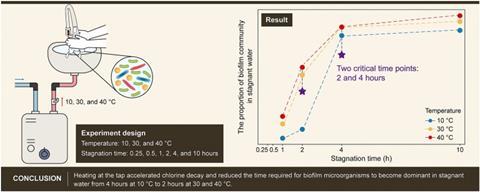Stagnant water in building plumbing systems is a well-known driver of microbial growth and contamination. Extended stagnation events—overnight, weekend, or weeks—have been extensively studied, with strong links to opportunistic pathogens including L. pneumophila.

However, shorter stagnation events of just a few hours, common in households and public facilities, remain poorly understood. Temperature also plays a critical role: while higher heating levels above 55 °C can suppress pathogens, they are impractical for touchless faucets that deliver water at warm temperatures for user comfort.
READ MORE: De-mystifying common misconception about the prevalence of Legionella bacteria
READ MORE: Changing the culture of Legionella testing
These unresolved issues raise pressing questions: how long can microbial water quality be preserved during short stagnation, and how does heating temperature influence safety? Due to these challenges, detailed research on short-term stagnation is urgently needed.
A team from the Research Center for Eco-Environmental Sciences, Chinese Academy of Sciences, in collaboration with partners from Georgia Institute of Technology, Michigan State University, and Delft University of Technology, has published (DOI: 10.1016/j.ese.2025.100624) new findings in Environmental Science and Ecotechnology (September 24, 2025).
The study systematically investigated microbial dynamics in touchless sensor faucets during stagnation periods of up to 10 hours at temperatures of 10 °C, 30 °C, and 40 °C. Their results reveal critical time points and temperature effects that reshape our understanding of microbial safety at the point of use.
Two pivotal shifts
Using high-resolution sampling, the researchers monitored chlorine decay, microbial biomass (ATP), bacterial diversity, and L. pneumophila gene copy numbers during short stagnation periods. Two pivotal shifts were observed: microbial diversity and water quality remained relatively stable for the first two hours, but between 2 and 4 hours, residual chlorine levels fell below 0.3 mg/L, microbial diversity collapsed, and biofilm-derived microbes began to dominate. After four hours, the microbial profile of stagnant water resembled that of biofilm, with DSSF69 spp. becoming dominant.

Temperature proved decisive. At 30 °C, microbial biomass nearly doubled compared to 10 °C, yet L. pneumophila growth was restrained. Conversely, 40 °C reduced total biomass but promoted steep increases in L. pneumophila concentrations, with a 260% rise after 10 hours. These findings indicate that neither higher nor lower temperatures alone guarantee safety. Instead, 30 °C offers a balance by minimizing L. pneumophila while maintaining manageable microbial activity.
The study highlights a short “microbial safety window” of 2–4 hours, after which risks increase significantly. For practical application, routine flushing after periods of inactivity and careful optimization of faucet heating between 30 °C and 40 °C are recommended.
Water management
“People often assume that microbial risks only emerge after long stagnation, such as overnight or during extended disuse,” said Prof. Gang Liu, corresponding author of the study. “Our results show that in touchless sensor faucets, significant changes can occur within just a few hours, particularly under warm conditions. The choice of heating temperature is also critical: while higher temperatures may inactivate some microbes, they can actually promote the growth of L. pneumophila. This makes it vital to rethink water management strategies in modern buildings.”
These findings carry important implications for public health and building design. Touchless faucets are increasingly popular in schools, hospitals, shopping malls, and transport hubs due to their hygiene benefits. However, without mixing valves, their water temperature is typically capped below 45 °C, making them vulnerable to microbial shifts during stagnation.
Identifying a 2–4 hour safety window provides a scientific basis for flushing practices and temperature settings. Balancing user comfort, energy efficiency, and microbial safety will be essential for sustainable water management. Further research should test multiple pathogens and expand guidance for green buildings, where reduced water use may inadvertently increase stagnation risks.
Topics
- Asia & Oceania
- Bacteria
- Chinese Academy of Sciences
- Clean Water
- Delft University of Technology
- Gang Liu
- Georgia Institute of Technology
- Infection Prevention & Control
- Infectious Disease
- Legionella pneumophila
- Michigan State University
- One Health
- Research Center for Eco-Environmental Sciences
- Research News
- stagnation
- UK & Rest of Europe
- USA & Canada







No comments yet